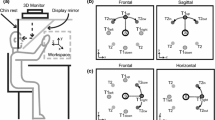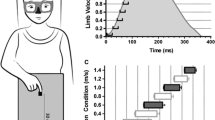Abstract
It has been proposed that visually guided reaching movements performed in the lower visual field (LVF) of peripersonal space are more effective and efficient than their upper visual field (UVF) counterparts (Danckert and Goodale 2001). In the present investigation we sought to determine whether this purported visual field asymmetry reflects advantaged processing of online visual feedback. To accomplish that objective, participants performed discrete reaching movements to each of three target locations in the LVF and UVF. In addition, reaches were completed under conditions wherein target location remained constant throughout a reaching response (i.e., control trials) and a separate condition wherein target location unexpectedly perturbed at movement onset (i.e., experimental trials). We reasoned that the target perturbation paradigm would provide a novel means to assess a possible superior–inferior visual field asymmetry for online reaching control. In terms of the impact of a target perturbation, both visual fields demonstrated equal proficiency integrating visual feedback for online limb adjustments. Interestingly, however, the spatial distribution of movement endpoints in the LVF was less than UVF counterparts (cf. Binsted and Heath 2005). Taken together, the present findings suggest that although LVF and UVF reaches readily use visual feedback to accommodate an unexpected target perturbation, reaches in the LVF elicit advantaged spatial benefits influencing the effectiveness of online limb corrections.

Similar content being viewed by others
Notes
Interestingly, Dichtl et al. (1999) reported that retinal nerve fiber thickness is greater at the inferior disc border than the superior disc border.
Danckert and Goodale (2001) report a LVF endpoint accuracy advantage for target “lengths” of 3.7, 7.5, 14.9 and 30.0 mm. A target “length” of 1.9 mm, however, did not produce a visual field asymmetry.
Research employing the double-step paradigm has shown that online movement corrections occur involuntarily (Goodale et al. 1986) via an ‘automatic pilot’ (Pisella et al. 2000) operating without awareness from the participant. It is important to note that the target perturbation used in the present investigation was explicit (e.g., Heath et al. 1998) and participants were aware of the need for online limb adjustments.
Previous research has shown that the proportion of endpoint variance explained by the spatial position of the limb at peak acceleration does not provide sufficient predictive power to explain unfolding reaching kinematics (see Heath 2005; Heath et al. 2004). Hence, in the present research R2 values for movement endpoints were restricted to the spatial location of the limb at peak velocity and peak deceleration.
Endpoint variability for trials involving a perturbation was greater than for trials involving a stationary target position. As stated elsewhere, increased endpoint variability is thought to represent inherent neuromuscular instability in the evocation of online limb adjustments (e.g., Khan et al. 2002).
References
Bédard P, Proteau L (2004) On-line vs. off-line utilization of peripheral visual afferent information to ensure spatial accuracy of goal-directed movements. Exp Brain Res 158:75–85
Beggs WD, Howarth CI (1972) The accuracy of aiming at a target: some further evidence for a theory of intermittent control. Acta Psychol 30:171–177
Binsted G, Heath M (2005) No evidence of a lower visual field specialization for visuomotor control. Exp Brain Res 162:89–94
Brown LE, Halpert BA, Goodale MA (2005) Peripheral vision for perception and action. Exp Brain Res 165:97–106
Bryden MP (1977) Measuring handedness with questionnaires. Neuropsychologia 15:617–624
Carlton LG (1981) Visual information: The control of aiming movements. Q J Exp Psychol 33A:87–93
Carnahan H, Goodale MA, Marteniuk RG (1993) Reaching versus grasping and the differential use of visual feedback. Hum Mov Sci 12:219–234
Chua R, Elliott D (1993) Visual regulation of manual aiming. Hum Mov Sci 12:365–401
Curcio CA, Allen KA (1990) Topography of ganglion cells in human retina. J Comp Neurol 300:5–25
Danckert J, Goodale MA (2001) Superior performance for visually guided pointing in the lower visual field. Exp Brain Res 137:303–308
Danckert J, Goodale MA (2003) The ups and downs of visual perception. In: Johnson SH (eds) Taking action: cognitive neuroscience perspectives on intentional acts. MIT, Cambridge, pp 29–64
Desmurget M, Epstein CM, Turner RS, Prablanc C, Alexander GE, Grafton ST (1999) Role of the posterior parietal cortex in updating reaching movements to a visual target. Nat Neurosci 2:563–567
Dichtl A, Jonas JB, Naumann GOH (1999) Retinal nerve fiber layer thickness in human eyes. Graefe’s Arch Clin Exp Opthalmol 237:474–479
Elliott D, Binsted G, Heath M (1999a) The control of goal-directed limb movements: correcting errors in the trajectory. Hum Mov Sci 18:121–136
Elliott D, Heath M, Binsted G, Ricker KL, Roy EA, Chua R (1999b) Goal-directed aiming: Correcting a force specification error with the right and left hands. J Mot Behav 31:309–324
Elliott D, Helsen WF, Chua R (2001) A century later: Woodworth’s (1899) two-component model of goal directed action. Psychol Bull 127:342–357
Fitts PM (1954) The information capacity of the human motor system in controlling the amplitude of movement. J Exp Psychol 48:303–312
Gan KC, Hoffman ER (1988) Geometrical condtions for ballistic and visually controlled movements. Ergonomics 31:829–839
Galati G, Lobel E, Giuseppe V, Berthoz A, Pizzamiglio L, Le Bihan D (2000) The neural basis of egocentric and allocentric coding of space in humans: a functional magnetic resonance study. Exp Brain Res 133:156–164
Georgopolos AP, Kalaska JF, Caminiti R, Massey JT (1983) Interruption of motor cortical discharge subserving aimed arm movements. Exp Brain Res 49:327–340
Goodale MA, Pelisson D, Prablanc C (1986) Large adjustments in visually guided reaching do not depend on vision of the hand and perception of the target displacement. Nature 320:748–750
Gréa H, Pisella L, Rossetti Y, Desmurget M, Tilikete C, Grafton S, Prablanc C, Vighetto A (2002) A lesion of the posterior parietal cortex disrupts on-line adjustments during aiming movements. Neuropsychologia 40:2471–2480
Handy TC, Grafton ST, Shroff NM, Ketay S, Gazzaniga MS (2003) Graspable objects grab attention when the potential for action is recognized. Nat Neurosci 6:421–427
Heath M (2005) Role of limb and target vision in the online control of memory-guided reaches. Motor Control (in press)
Heath M, Hodges NJ, Chua R, Elliott D (1998) On-line control of rapid aiming movements: unexpected target perturbations and movement kinematics. Can J Exp Psychol 52:163–173
Heath M, Weir PL, Roy EA (1999) Visual-motor integration of unexpected sensory events in young and older participants: a kinematic analysis. Dev Neuropsychol 16:197–211
Heath M, Westwood DA (2003) Does a visual representation support the online control of memory-dependent reaching? Evidence from a variable spatial mapping paradigm. Motor Control 7:346–361
Heath M, Westwood DA, Binsted G (2004) The control of memory-guided reaching movements in peripersonal space. Mot Control 8:76–106
Held R. Gottlieb N (1958) Technique for studying adaptation to disarranged hand-eye coordination. Percept Mot Skills 8:83–86
Keele SW (1968) Movement control in skilled motor performance. Psychol Bull 70:387–403
Khan MA, Elliott D, Coull J, Chua R, Lyons J (2002) Optimal control strategies under different feedback schedules: Kinematic evidence. J Mot Behav 32:45–57
Khan MA, Lawrence GP (2005) Differences in visuomotor control between the upper and lower visual fields. Exp Brain Res 164: 395–398
Krigolson O, Heath M (2004) Background visual cues and memory-guided reaching. Hum Mov Sci 23:861–877
Lakha L, Humphreys G (2005) Lower visual field advantage for motion segmentation during high competition for selection. Spat Vis 18:447–460
Langolf GD, Chaffin DB, Foulke JA (1976) An investigation of Fitts’ law using a wide range of movement amplitudes. J Mot Behav 8:113–128
MacKay WA (1992) Properties of reach-related neuronal activity in cortical area 7A. J Neurophysiol 67:1335–1345
MacKenzie CL, Marteniuk RG, Dugas C, Liske D Eickmeir B (1987) Three dimensional movement trajectory in a Fitts’ task: Implication for control. Q J Exp Psychol 18:629–647
Maunsell JH, Van Essen DC (1987) Topographic organization of the middle temporal visual area in the macaque monkey: representational biases and the relationship to callosal connections and myeloarchitectonic boundaries. J Comp Neurol 266:535–555
Meyer DA, Abrams RA, Kornblum S, Wright CE, Smith JEK (1988) Optimality in human motor performance: ideal control of rapid aimed movements. Psychol Rev 95:340–370
Mountcastle VB, Lynch JCGA, Georgopolous A, Sakata H, Acuna C (1975) Posterior parietal association cortex of monkey: command function for operations within extrapersonal space. J Neurophysiol 38:871–908
Oliveira FT, Elliott D, Goodman D (2005) Energy-minimization bias: compensating for intrinsic influence of energy-minimization mechanisms. Mot Control 9:101–114
Paulignan Y, Frak VG, Toni I, Jeannerod M (1997) Influence of object position and size on human prehension movements. Exp Brain Res 144: 226–234
Pelisson D, Prablanc C, Goodale MA, Jeannerod M (1986) Visual control of reaching movements without vision of the limb. II. Evidence of fast unconscious processes correcting the trajectory of the hand to the final position of a double-step stimulus. Exp Brain Res 62:303–311
Pisella L, Grea H, Tilikete C, Vighetto A, Desmurget M, Rode G, Boisson D, Rossetti Y (2000) An ‘automatic pilot’ for the hand in human posterior parietal cortex: toward reinterpreting optic ataxia. Nat Neurosci 3:729–736
Previc FH (1990) Functional specialization in the lower and upper visual fields in humans: its ecological origins and neurophysiological implications. Behav Brain Sci 13:519–575
Previc FH (1998) The neuropsychology of 3-D space. Psychol Bull 124:123–164
Stubbs DF (1976) What the eye tells the hand. J Mot Behav 8:43–48
Vince MA (1948) Corrective movements in a pursuit task. Q J Exp Psychol 1:85–103
Westwood DA, Goodale MA (2003) A haptic size-contrast illusion affects size perception but not grasping. Exp Brain Res 153:253–259
Woodworth RD (1899) The accuracy of voluntary movement. Psychol Rev, whole no. 13 (Monograph Supplement)
Author information
Authors and Affiliations
Corresponding author
Rights and permissions
About this article
Cite this article
Krigolson, O., Heath, M. A lower visual field advantage for endpoint stability but no advantage for online movement precision. Exp Brain Res 170, 127–135 (2006). https://doi.org/10.1007/s00221-006-0386-x
Received:
Accepted:
Published:
Issue Date:
DOI: https://doi.org/10.1007/s00221-006-0386-x




